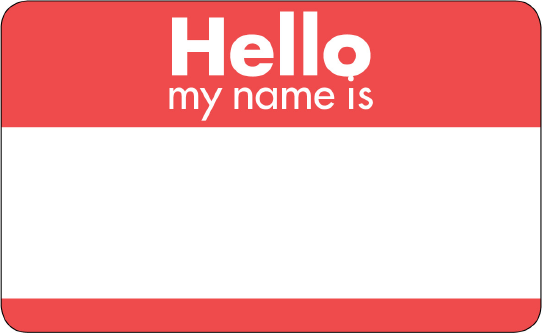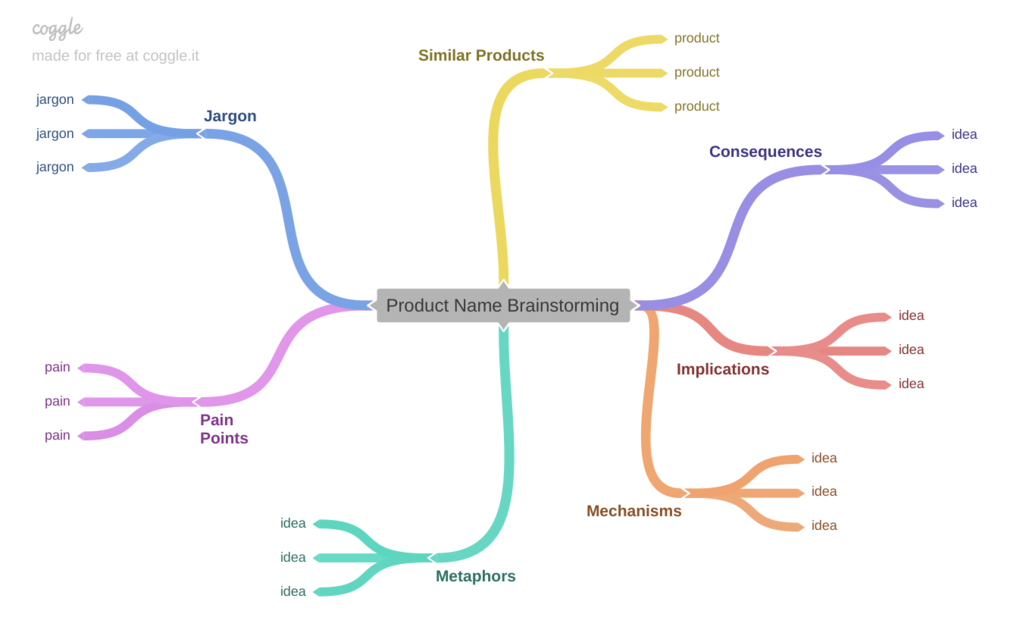Name Your Next Product With This Exercise

How do you come up with a product name? or a business name? Naming products is a hard but learnable skill. There are agencies that provide names-as-a-service. ZinZin’s existence corroborates the idea that naming can be distilled into a repeatable process.
When you’re feeling stuck, it helps to have a process. Prolific creation is the play here: When you’re stuck trying to come up with a name, it’s easier to come up with 100.
This is my current iteration on a naming process. It’s based on prior work from The ZinZin Naming Guide, the article A Good Name Points to You from Ribbonfarm, and Jane Portman’s guide to Naming your next book.
After reading this guide, you should have a process you can use next time you are coming up with a name for your next product, website, article, or creative project.
Step 1: Create an 7-column table or mindmap
You’ll need somewhere to collect your ideas. Use whatever style works for you; I prefer mindmaps on paper. Y can use a tool like Coggle or a spreadsheet. Then, create 7 sections:
- Similar products – names of competitive books, apps, whatever
- Mechanisms – how your product works
- Implications – what your product does
- Consequences – the result of your product
- Pain points – pain your products solve
- Jargon – related terms from your audience that could relate to your product.
- Metaphors – potential metaphors that you could tie to any of the previous 6
The steps here aren’t ordinal. You can bounce back and forth; ideas from one may inspire others.

Playing Creative Offense & Defense
On The Knowledge Project, Sendhil Mullainathan talked about the idea of creative offense and defense. Creative Offense is coming up with as many unfiltered ideas as you can. Creative Defense is filtering those ideas down into the best actionable ideas from earlier.
By decoupling your creative mind from your critical eye, you empower both to work at their best.
That’s the approach I’m recommending here: coming up with several names, then filtering down.
Step 2: Decomposition
Start by breaking down your product idea. How does it work? What does it do? What results does it deliver? You can decompose your product to fill out the first three sections:
Things decompose into mechanisms, implications, and consequences. The mechanism is how it works. The implication is what it does. The consequence is what it means for the lives of the audience you’re trying to reach.
Carlos Bueno, A Good Name Points to You, Ribbonfarm
Identifying these parts of your application will inform the mechanisms, implications, and consequences sections.
Examples:
- Mechanisms: S3, aka Simple Storage Service.
- Implications: SentinelDB. The metaphor implies that it stands in front of your data, protecting it.
- Consequences: Double Your Freelancing Rate. A crispy definition of what happens to your career.
Step 3: Research
Step two is to look inward for ideas. The next step is to look outward. What are others doing in your niche? You shouldn’t plagiarize, but you can get an idea of how your audience talks and use that data to come up with ideas you could connect with. There are three data points here: similar products, pain points, and jargon.
Similar Products – Start looking at naming schemas from similar products. For example, let’s say I was making a tech podcast. I see patterns of including “cast”, “show”, “podcast”, and “talk” in the name.
Pain Points – What problem does your product solve? You’ll see this technique often in book subtitles. For example, How to Do Nothing: Resisting the Attention Economy.
Jargon – How does your audience talk? What are their terms of art? When Adam Wethan & Steve Schoger named their book teaching design in developers, they were translators between two worlds. They need to describe design techniques in geek-speak. They landed on the brilliant moniker Refactoring UI.
Metaphors – New ideas are more resonant when you can connect them to existing ideas with your audiences’ minds. For example, Steven Pressfield’s The War of Art connects Sun Tzu’s classic work to the inner struggle of creative work.
Go through each of the sections, and come up with examples for each. Hopefully, one column will inspire another and give you plenty of creative clay to work with.
Step 4: Connect & Create
Once you have your ideas, it’s time to start synthesizing new ideas from them. Mix, match, combine and write down whatever comes to you.
Add a new section of your document, or start a new document.
Remember that you are aiming for quantity, not quality here. Go wide. Big, blue ocean thinking. The beauty of creative offense is that the quantity will get you to the quality.
Step 5: Filter & Decide
Once you have your name, it’s time to filter down into something that works. Maybe in the exercise, you came up with something that really makes your heart sing.
To help you decide, you could set some constraints on the name. This will vary depending on your niche and type of product, but here are some potential rules:
- Can you get a decent domain? If you need a domain for the product, are you able to get one?
- Is the name simple enough? Clear > clever. Will people understand your name? Is it too wordy, complex, or hard to spell?
- Will it get you in trouble? Be aware that if your name is too inspired by a competitor, you could find yourself on the receiving end of a cease & desist.
- Can you say it out loud? Call it word of mouth optimization. Imagine someone recommending your product to a friend. How does it sound? For an anti-example, see mmhmm.
You may have other constraints. Consider those and eliminate names that don’t work. Eventually, you should be able to find something that works. If not, you can always repeat the previous steps and come up with more ideas.
Did you come up with a good idea using this system? Let me know what it is over Twitter @GSto , I’d love to hear it.